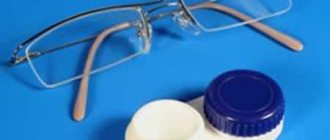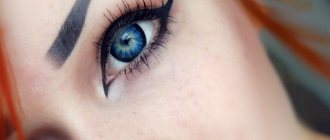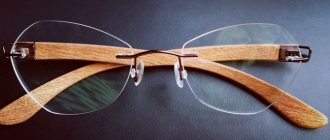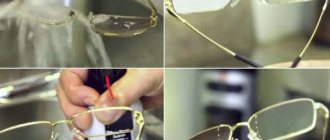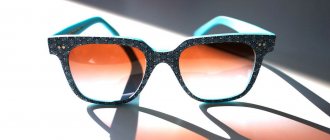Single vision lenses are lenses that have the same optical power over their entire surface. They are prescribed for myopia or farsightedness. For their manufacture, both traditional and highly refractive materials can be used. The latter are used to reduce the thickness and weight of the product. Single vision lenses are divided into spherical and aspherical. At the same time, modern corrective optics can have both a front and rear aspherical surface. For some lenses (bispherical), both the front and rear surfaces are aspherical.
Indications for wearing bifocal glasses
Widely used in some professional fields. Bifocal lenses are often required by jewelers, newspaper editors, and watchmakers when a quick change of focus is required and there is no time to change into other glasses.
Prescribed to patients with deterioration of visual perception due to aging of the tissues of the optical system. They are prescribed for various purposes - from reading to playing billiards. You can purchase an accessory after consulting an ophthalmologist and conducting a comprehensive diagnosis.
Which lenses to choose for glasses? Basic information
Every competent specialist will tell you that the key parameters when choosing glasses are the following:
- refractive index;
- design;
- material;
- coating.
In order to make it more clear what we are talking about, we will consider each criterion separately. Such a characteristic as the “refractive index” is perhaps the most important. When we talk about it, we mean the thickness and volume of the lens.
If the index is high, then the volume and thickness are less, and vice versa. A high refractive index of the lens is necessary for correction in the following cases: when there is a high degree of refraction, when vision correction is necessary for a child, when a person chooses rimless frames. It is also worth noting that this type of lens transmits light poorly, which can also negatively affect picture quality and eye health. In order to eliminate this drawback, an additional coating is applied to the lenses, which helps eliminate glare.
The next important parameter is the design of the lens. There are usually four types of lenses:
- spherical:
- aspherical;
- bifocal;
- progressive.
The first type of lenses is also called stigmatic. They are found in all traditional glasses models. They are spherical in shape, and one of the key advantages of such lenses is that they reflect light well.
The second type, aspherical lenses, are flatter in shape, which is an advantage compared to the previous type. Why? Such lenses not only guarantee high image clarity, but also preserve lateral vision, and do not distort the size of the eye when a person is looked at from the side. Bifocal lenses are lenses that are divided into two sectors: one for looking at objects in the distance, the other for looking at objects near. They are located, respectively, at the top and bottom. This type of glasses lens is needed for those who have been diagnosed with presbyopia at an early stage by ophthalmologists.
There are also progressive lenses. They are more complex than bifocals, but have a number of significant advantages. In these vision correction products, the change of sectors occurs very smoothly: from the upper zone through the intermediate zone to the lower. This means that the quality of vision of a person using this type of lenses for glasses increases dramatically. As for external characteristics, progressive models are no different from the rest, and all because the optical power changes thanks to an improved system of surfaces, and not an additional sector.
The material from which eyeglass lenses are made can be of two types: glass and plastic.
Glass, or mineral, have the following advantages: durability, protection from ultraviolet rays, high throughput. Among the disadvantages, it is worth highlighting the low shockproof properties. In turn, plastic ones are distinguished by greater strength. It is also worth noting that they retain optical properties in extreme conditions, can easily withstand high temperatures and are absolutely safe to use. However, this type of lens also has a drawback - the plastic quickly scratches, which leads to deformation. They, in turn, can affect the quality of the picture. Fortunately, this issue has already been partially resolved - modern manufacturers produce special coatings that help preserve the original appearance and also protect lenses from mechanical damage. Currently, companies that specialize in the development and production of eyeglass lenses also make products from organic materials. These include: thermoset (used more often than other materials), thermoplastic and quasi-thermoset. The latter are, rather, the totality of all the positive qualities of the first and second types.
The list of important characteristics that should also be taken into account when choosing lenses for glasses includes such a parameter as coating. It is important to know that in ophthalmology today a large number of coatings are used, which are not only responsible for the safety and protection of eye health, but also contribute to the comfortable wearing of glasses throughout the entire period of use. The coatings are:
- strengthening (used for application to the external and internal sides in order to minimize the effects of mechanical impact);
- antireflective, which reduces the reflection of light rays, which improves the brightness and clarity of the image;
- The mirror coating, in turn, is purely cosmetic and does not in any way affect the optical characteristics of the glasses.
Lenses can also be coated with an anti-reflex coating to reduce glare that makes eye contact difficult. Plus it improves image quality. Anti-reflective coating is necessary for those who spend a lot of time interacting with bright light.
The hydrophobic coating will help protect the lenses from excessive contamination. Moreover, it prevents them from fogging when the temperature changes. Today, the modern ophthalmology market is being improved on a regular basis, which makes it possible to create multifunctional coatings for spectacle lenses, thereby solving several problems at once.
Varieties
Glasses with two lenses function on the same principle. Optical zones remain invisible to others. Bifocal lenses are distinguished by the location of vision zones:
- Concentric - with optical rings.
- Aspherical - located closer to the face. Compared to spherical ones, they are lighter and thinner, and have a flatter shape.
- Variables - there is a line to demarcate segments.
Bifocal accessories cost from 1,500 to 15,000 rubles. Cheap models practically do not differ from the functioning of expensive products. There are also linear and progressive bifocal glasses. The former have a design with a visual horizontal line in the center, the latter are equipped with a smooth focus transition.
Other modern types of lenses:
- Trifocal - characterized by dividing the optical zone into three parts. The top one is for close-up, the central one is for intermediate distances, the bottom one is for distance. The main disadvantage is the limited scope of use. They are often called office ones. Adaptation – up to 10 days. Trifocal glasses are inexpensive. Budget accessories cost between 2000–5000 rubles.
- Multifocal - non-contact vision-correcting products with variable focal length. A person can see clearly near and far, and can also distinguish objects at intermediate distances. The key features of multifocal lenses are modernity, individuality, and high quality. This is the most expensive type of vision correction. The cost of one pair reaches 10,000 rubles.
No species can be called perfect. Each patient is selected with a personal vision correction device, focusing on lifestyle and other factors.
How to get a prescription
Bifocal glasses should only be prescribed to a person by an ophthalmologist. At the same time, attention is focused on the following points:
- The glasses model is selected individually. The optics that are ideal for one person may not be suitable for others to wear.
- If optics are used for different purposes, you should consider purchasing a pair of these glasses. This is true for drivers and teachers. The latter need to often look at the class, focusing their vision in the middle segment. But when checking notebooks, the eyes look down.
- If a person is not satisfied with the aesthetic side of the issue, then he can ask the doctor to prescribe bifocal lenses. They do not distort the shape of the eye at all and are almost not felt.
There are two types of bifocal lenses - linear and progressive. A characteristic feature of the former is a horizontal line, which usually runs clearly in the middle. With the second type of optics, focus shifts smoothly.
It is worth considering that getting used to such optics can be extremely problematic. The adaptation process may take several weeks.
Benefits of bifocal lenses
Two-in-one glasses are made to order from modern polymers.
Positive characteristics:
- No need to carry two pairs of glasses with you. Bifocals allow you to clearly distinguish objects near/far.
- Available to every patient. There are quite budget models that are no different from expensive ones.
- Determination of sizes, diopters and adjustments is carried out individually for each patient. However, this can be considered a disadvantage. If you lose your glasses, you won’t be able to just go into an optical shop and buy them in an instant. You will have to go through the examination again and wait for production.
- The shape and type of frame, center-to-center distance and other parameters are taken into account.
- It is possible to manufacture optics with different parameters for the organs of vision.
Additionally, salons offer the application of anti-reflective, hardening and other coatings. If necessary, tint. Products made to order are considered ideal, best suited to the individual requirements of the patient.
Operating principle
Thanks to bifocal lenses for glasses, a person does not need to carry several pairs at once. It is enough to focus your gaze on one of the parts of the glass to clearly see near and distant objects.
Manufacturers pay special attention to the lower lens; it is this that helps to distinguish close objects. A person often examines various objects close up, both at home and at work. The location of such a lens on the bottom of the glass is not accidental. When looking at close objects, a person most often looks down. Only sometimes an optical device for viewing objects closely is placed at the top of the glass. Such glasses are often used by watchmakers, jewelers and representatives of other professions in which working with small details is important.
It happens that the top part is made of ordinary glass. These glasses are necessary for people who suffer only from myopia. The lower lens can be of completely different sizes and shapes. It can occupy either half of the glass or a small part.
Bifocals help people with vision problems see objects at different distances.
Disadvantages of bifocal lenses
Double lens glasses are not as flawless as ophthalmologists describe. Bifocal models have a number of disadvantages:
- There are blind spots.
- The period of adaptation is long. You can't wear glasses all the time from day one. Initially put on for an hour, then for 3, gradually increase the duration of wearing, focusing on your own feelings. During the adaptation period, headaches, nausea, and pain in the eye area may appear.
- Constantly moving the gaze from one optical zone to another quickly leads to the appearance of asthenopia and discomfort. Therefore, the difference between diopters should not exceed 5 units. This drawback can be corrected by purchasing progressive rather than linear lenses. The transition in the latter is smooth and does not cause discomfort when frequently looking from a distant to a near object and vice versa.
- Drivers have to spend a long time using the central gaze zone. Therefore, they are rarely prescribed bifocal models. People who have to drive vehicles or dangerous machinery for a long time are recommended to buy trifocal glasses.
Lens design
The general shape of the large lens and the shape of the insert can be any and depends on both aesthetic preferences and the needs of the owner.
If you have to read often, it is more convenient for the reading field to occupy the entire lower part of the lens (the so-called “halves”), and sometimes even most of it
Picture with bifocals
Often the optical zones turn out to be decentered, that is, the center of the lenses (coinciding with the axes of the pupils) at the top and bottom of the lens are different.
Bifocal Lens Zones
For rare use of the “near zone”, lenses with small windows are more suitable.
Forms of bifocal and trifocal lenses
Since the window in a bifocal lens is always noticeable, they try to make it an original shape so that it adds style to the owner. For example, “halves” and “emoticons” are very popular.
Of course, bifocal lenses can be tinted for sun protection in the same way as regular lenses, and this can even hide the presence of “special zones” in the lens to some extent.
Sprayed bifocals
Getting a prescription
Optics with double lenses are selected based on the following parameters:
- professional activity
- sedentary or active lifestyle;
- parameters of visual perception.
For each patient, glasses are selected individually, after undergoing a thorough ophthalmological examination.
To obtain a prescription from an ophthalmologist, you will need to check your visual acuity using the Sivtsev table and undergo an examination called refractometry, which evaluates the refractive power of the visual apparatus.
The examination is carried out in government institutions, private clinics and optical salons.
The prescription indicates the date, OD and OS for each eye in a separate column. Next, indicate the degrees which glasses the patient requires. Lastly, they write who they are intended for, age, stamp and signature of the doctor.
This is what a prescription for eyeglasses looks like:
During the consultation, the ophthalmologist will recommend which type of lenses is best for the patient. If there is no need for this optics, he will suggest regular reading glasses.
If the patient has difficulty seeing near and far, a plus lens is installed at the top, and a minus lens at the top. Sometimes the position changes, the negative one is placed at the top. This is required if a person’s work involves looking at objects above eye level.
If a vision correction device is selected for reading or working more often than for viewing objects at a long distance, then the lens located in the lower optical zone occupies half of the glass surface.
The placement of the minus and plus lenses may vary depending on the needs of the person who comes for diagnosis. For example, minus lenses are placed in the lower corners of the glass near the bridge of the nose if the optics are purchased more for distance than for near.
Advantages and disadvantages
The main advantages include the following characteristics:
- replace several pairs of ordinary ones;
- profitable from a financial point of view, as they cost little more than classic ones;
- It is possible to fine-tune the refractive power of lenses and their sizes, taking into account the individual characteristics and needs of the patient.
Disadvantages include:
- inapplicability in certain types of activities when there is a need for prolonged use of the central area of gaze (driving a car);
- numerous turns of the head may cause a feeling of nausea, migraines, and pain in the eyes;
- Bifocal glasses cause discomfort for many people. It seems to them that optics are prescribed for the reason that they are old and wearing them shows their age;
- the dividing line in the two focal glasses is quite noticeable. The distance at which a person can see normally is limited.
Before purchasing, you should definitely consult a doctor and undergo an examination.
They can be purchased at different prices. The price depends on the choice of brand and frame.
If the issue of purchasing has already been decided, be sure to visit an ophthalmologist, who will prescribe the necessary glasses, taking into account individual parameters.
Consumer Reviews
Vera: I’ve been using it for a little over a year. I'm very glad that I don't have to wear two pairs of glasses. You can always see well far and near. It took me a long time to adapt to bifocal lenses.
Andrey: Vision correction is ideal for age-related changes. The only drawback is the long adaptation time. It takes time to get used to focusing your eyes correctly. You need to look at your feet, tilting your head strongly. If I look as usual, I risk stuttering, since the lower part involves looking at nearby objects.
Choose lenses for glasses. What else is important to know?
Before purchasing glasses lenses, you need to have your eyesight checked, especially if you are buying them for the first time. But even if not, it is worth repeating the diagnostic procedure, since vision may deteriorate.
After the examination, the ophthalmologist, taking into account the individual characteristics of the visual organs, the period of use of the optics and the purpose, will answer the question “Which lenses to choose for glasses?” and will help make the selection.
For example, if you are farsighted, then, obviously, the doctor will prescribe plus lenses for glasses, and if you are nearsighted, then minus lenses are needed. According to some ophthalmologists, it is better to choose high-index glasses for vision correction, as they have thinner lenses. Let's give another example: bifocal or progressive lenses should be worn by people who experience age-related changes in their visual organs. They are often prescribed by a specialist.
Bifocal glasses
The invention belongs to Benjamin Franklin . He took 2 pieces of glass (for farsightedness and myopia) and cut them in half, connecting the halves.
On one surface there are 2 optical zones for different distances. The upper part, which is larger in area, is necessary for distant vision, the lower part for close vision. The farsightedness segment is located on the model so that the gaze is clearly on the optical center.
Appearance: on a large surface below there is another, smaller one. Clear boundaries are visible, but the specimens are made of solid glass.
The difference between the two segments should not be more than 3 diopters . The transition between them causes inconvenience, the eyes get tired after prolonged wear.
The size of the segments on bifocal glasses is adjustable depending on a person’s lifestyle.
In modern times, this type is considered obsolete due to the inconvenience of wearing and the availability of better analogues.
Advantages:
- Replace 2 vision devices at once.
- No need to carry a spare pair with you.
- Financial benefit.
Flaws:
- The distance is too short for good vision.
- The appearance distorts the human eyes (the outer eyelid increases due to the lower segment of the glass).
- Sudden movements of the head may cause headache and nausea.
- Externally they add age to the wearer.
- Long-term addiction.



